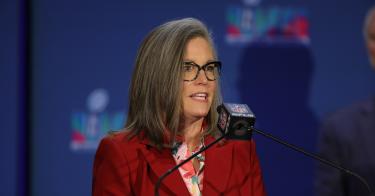Arizona’s then-Gov. Doug Ducey signed a law last year establishing America’s most expansive school-choice program. Mr. Ducey’s successor, Katie Hobbs, seeks to undo that progress.
Arizona established education savings accounts, which it styles Empowerment Scholarship Accounts, in 2011. With an ESA, parents can use a portion of their child’s state education funds—about $7,000—to pay for private-school tuition, tutoring, textbooks, online courses, home-school curricula, special-needs therapy and other expenses. Last year’s law abolished eligibility limits and made ESAs available to all K-12 students in the state. Ms. Hobbs’s proposed budget would undo the expansion, leaving only around 1 in 4 students eligible.
In her first State of the State Address, she assailed the Legislature for expanding the program and warned it “will likely bankrupt the state.” She claimed the new law is “poised to cost Arizona taxpayers an estimated $1.5 billion over the next 10 years if left unaddressed.”
But there’s an obvious problem with her math. Arizona spends more than $12,000 a pupil on its public schools, while the typical universal ESA award amount is only $7,000. Ms. Hobbs counts the cost of the program but ignores the fiscal benefit. An analysis from the nonpartisan Common Sense Institute finds that the ESA program will save taxpayer money.
>>> Arizona Shows the Nation What Education Freedom Looks Like
The ESAs are funded with 90% of the state’s per pupil expenditure, but none of the federal or local portion, which means that each student who uses an ESA instead of enrolling in a district school generates savings for taxpayers.
The state Education Department reports that traditional public-school enrollment has declined by nearly 31,000 since 2019 and is now more than 70,000 below the 2019 budget projections. The Common Sense Institute calculates that this decline generates more than $500 million in annual statewide savings, more than offsetting the $377 million annual projected cost of the full ESA program. Meanwhile, Ms. Hobbs proposes to spend $1.34 billion on “new executive initiatives,” belying her profession of concern for the taxpayer.
Arizona’s Legislature remains narrowly under Republican control, and the leaders of both chambers have pronounced the governor’s budget dead on arrival. “First of all, Arizonans want school choice,” House Speaker Ben Toma said in response to Ms. Hobbs’s speech. “I don’t think giving parents choice is equivalent to anti-public-education.”
The governor has a line-item veto, but Ms. Hobbs won’t be able to use it to limit ESAs, which are funded by formula tied to money for public schools. That means she’d need Republican lawmakers to cross party lines.
That would be risky for them. A Morning Consult tracking poll this month found 67% of Arizonans and 77% of parents with school-aged children support ESAs. Enrollment has surged to 45,000 from 10,000 since the expansion. Even Ms. Hobbs should think twice before alienating these constituents.
This piece originally appeared in The Wall Street Journal on 01/16/23





